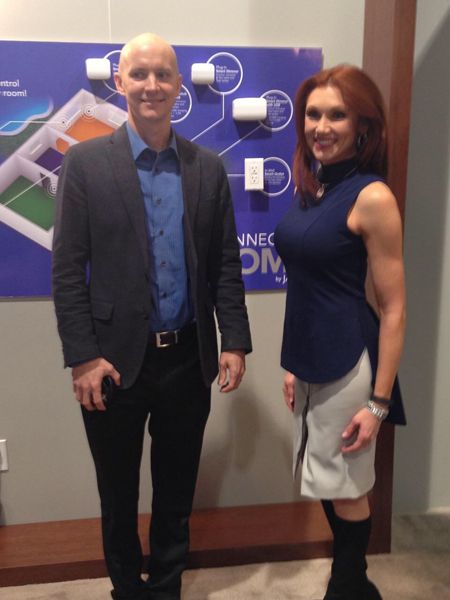Day two at CES...we came, we saw, we learned. A lot! Before walking the ginormous floor to see the thousands of exhibits, we sat in on a morning keynote speech. The message we came away with? "Innovate or die." These words were spoken by Gary Shapiro, President and CEO of CEA (Consumer Electronics Association), and they resonated.
Those three little words are essentially the mantra of CES, and they ring truer than ever. Learning about some of the technologies on the horizon and the brilliant ideas that will soon become reality, it's hard to imagine any of the the hundreds in attendance leaving that room uninspired or not in awe of the products and devices we could be using in the very-near future.
Among the amazingly innovative tech trends you're soon to see are monitored healthcare via wireless sensors, drones that can do everything from enhance the Hollywood filming experience to make rooftop deliveries at businesses, 3D printing that literally creates something from thin air and places it into your hands, and vehicles that are completely driverless.

Mark Fields, President and CEO of Ford Motors, took the stage to discuss the aforementioned autonomous vehicles and quite a few other interesting topics being developed within the auto industry, and more specifically, by Ford. Among those were connectivity between drivers and cars, predictive technology, and social collaboration. What exactly does that mean? Check out these ideas...
- Technology that learns the reasons for your trips and your driving behaviors, which could result in personalized insurance rates.
- Car sharing, car swapping, and on-demand driving, all set up through mobile devices, helping commuters and drivers in cities all over the world.
- Rapid recharging and sharing of electric vehicles to help reduce harmful emissions.
- Parking spotter technology to help you find the closest and cheapest parking, painless parking that guides you throughout the terrifying process of parallel parking.
This type of technology goes far beyond use in vehicles; sensor technology, the focus on social platforms and connectivity--this will have major ramifications on virtually every aspect of everyday life. Of course, not everything at CES is as world-changing as driverless cars and 3D printers that can make objects appear out of thin air… sometimes, you’ve gotta have a little fun with your technology.

{Program Host Jacque Gonzales checked out all the ways to "get connected"!}
The living room has evolved. In the '80s, things were simple. You had maybe one TV in your house. Video games were played in the living room, with the person next to you, end of story. By the mid-'90s, the graphics had changed, but the living room itself? Not so much. Sure, having second (or third or fourth) television sets in the house wasn't unusual, but the biggest TV was still your main entertainment hub. Now? Picture this: your whole family is together in the living room, playing video games--but you're each doing something different. Your son uses voice commands to switch from live TV to video games, instantly jumping online to play with friends in other states or countries. Your daughter is curled up on the couch with her handheld gaming system, which houses dozens of digital games on its memory card. Your husband's got his favorite mobile games going on his tablet, and you're enjoying a raid with your guild on your laptop. That's the present of gaming--so many ways to play, so many ways to connect.
{Program Host Jacque Gonzales is well-protected by Iron Man!}
And for the future? In the SuperSession "Emerging Trends in Gaming," we heard all about what's on the horizon when it comes to video games. The good news is, there will be more and more ways to get the games you want. For years, there were consoles, a handheld or two, and PCs, and that was it. Now, your options are almost limitless. You can go to the store and buy physical games. You can download games to almost any device you own. You can order online. You can stream games via services like PlayStation Now. It's all about options, and the companies that were ahead of the curve in social and mobile gaming (think Rovio's Angry Birds) are paving the way for what's becoming the standard.

{Program Host Albany Irvin hangs with her new friend, #RobotButler at the Quirky booth}
But that's not all! One of gaming's biggest emerging trends is VR, or virtual reality. It sounds like science fiction, but these VR headsets, like the Facebook-acquired Oculus Rift or Samsung's Gear VR let you strap on a headset and get up close and personal with your games. And, as Oculus' Jason Rubin pointed out, VR is exciting for reasons that go far beyond video games. Once the technology becomes mainstream, there's no limit to what it can be used for. Use a headset to turn a less-than-ideal seating arrangement (on a cramped plane, perhaps) into your own personal theater. Virtual reality headsets can be used as training devices, theoretically--just picture a fleet of med students learning to "operate" with a headset on. Or perhaps, in another example used by Rubin, you could build your dream house and use a VR tour to show your architect exactly what you're looking for.

Those hypotheticals are still a ways off, but it's exciting to think about how a technology developed for entertainment--gaming--could have limitless practical uses. In the meantime, get back to your favorite games--those Angry Birds: Star Wars high scores aren't going to beat themselves! And don't forget to check back in with us as we spotlight more inventive products and ideas at CES--including some of the 2015 CES Innovation Award honorees.
